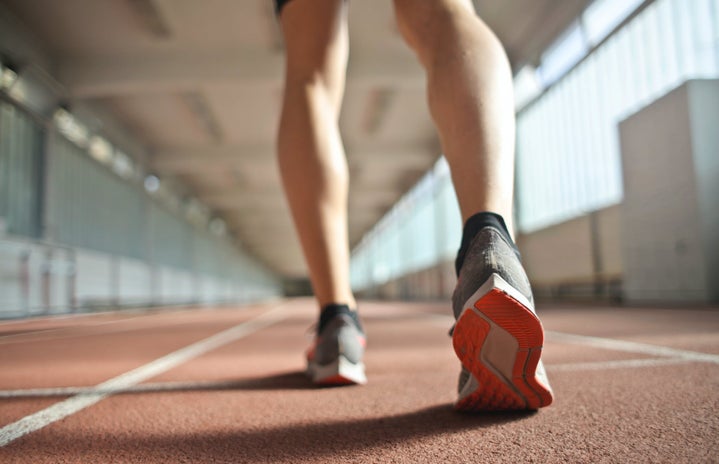Everyone knows that it’s healthy to exercise. Everyone knows that your body will thank you in the long run when you work out and get your body in shape. Everyone knows that you feel good mentally and physically after moving your body. Exercising is all things positive and nothing negative… right?
No one wants to be a lazy couch potato— No way! We’re better than this, why don’t you go for a run or something? Get on your shoes, find a running path, and don’t forget your water bottle. You start moving your feet, slow at first, but then it’s time to pick up the pace. Before you know it, you feel that familiar acidic sensation inside, you’re running out of breath and drenched in sweat, but you persevere. Finally, it feels so good when you slow down and take a seat.
I was always into running, a big reason was my dad. He was the one who encouraged me to join the cross-country team in middle school because I needed an extracurricular activity, and he was a huge runner himself anyway. We only had three weekly practices, around an hour and a half each. Meets were slightly over a mile long, maybe two, but they weren’t easy. However, it was so worth it in the end when you crossed the finishing line with people cheering for you left and right! The satisfaction after seeing your time at the finish line, as well as online with rankings, was fulfilling to see. I enjoyed the sport greatly, so I decided to continue running in the coming years.
In high school, I could feel the intensity pick up. We had four practices a week, an optional practice on Sunday, and on Thursday we were encouraged to either run or swim on our own outside of practice. At this time, the academic load was starting to pick up too, so I had to balance 2+ hours of practice with school, which started at 7:30 am. To say I was exhausted at the end of the day was an understatement. The meet length changed as well, as we had to run 5ks almost every week. But I learned how to condition myself. As a sophomore, I decided to branch out and try track and field. It’s similar to cross country, but with more sprinting and the environment being even more fast-paced.

I was adjusting to things and so were my peers. At least, the majority of them were. I noticed that some of the students would have a brace on their legs or an ice pack resting on a knee. These runners were usually on the more competitive side, and they were incredibly fast. It’s probably because they practiced a lot harder than I did, even outside of practice. Yet, they were still running normally as if no brace existed.
I didn’t know if it was necessarily a good idea to run with a brace, or even take it off and put it back on after the run. Wasn’t this where the soreness was? Running would only put more pressure on the area– don’t get me started on sprinting!
I tried other sports while in high school, but I wanted to run again during college. However, I noticed the cross country and track and field college teams were for serious student-athletes and had intense workouts and meets, so joining wouldn’t be easy. Unfortunately, there were no club sports dedicated to running. At the activity fair, there were student clubs for every single sport, but only one club was dedicated to track and field (that welcomed all paces). There were none related to cross country or even just casual running. What happened? Why must running always be treated as intense? What happened to let your body flow naturally? For one of the most basic sports on the planet, why are the options limited?
My parents taught me to do everything in moderation, and exercise was no exception. Of course, you need to move your body but don’t overwork yourself either to a state of burnout. Your body looks out for you, so you should treat it with kindness.
Imagine a mountain covered in rocks, and Person A and Person B want to get to the top. Person A runs straight up the rocks at full momentum. Person B goes at a much slower pace but learns how to strategically maneuver on top of them. In the end, when both Person A and Person B make it to the top, you can tell one is much more bruised than the other. Which person’s strategy would you choose?
Many people take it upon themselves to run every single day. They fit in intense workouts for every day of the week, which doesn’t allow for any slacking off. But is it a good idea to run every day? According to Healthline, it can be beneficial because it decreases the risks of a heart attack, or stroke, and can even extend a few years of your life. Not to mention the more immediate benefits such as better sleep and concentration.
However, there are also risks. For instance, according to Everyday Health, conditions like runner’s knee can develop because of the continual stress of joints, ligaments, and tissue that are being exerted. Another issue is chafing, when skin rubs against something frequently, like clothes. Running also largely increases the risk of something called “Dead Butt Syndrome,” which is when muscles in the buttocks stop working.
So, what should we do? What if you want to run frequently but don’t want to risk injuring yourself? The simple answer is moderation, as I said before. However I’m not telling you what to do, want to run every day, that’s up to you. My suggestion is– it doesn’t have to be intensive. In fact, shoe companies like Asics and Nike have tips on how to run daily safely. Just because you don’t train as hard or long doesn’t mean you don’t care. As the saying goes, small steps still move you forward!
You can take days off, too. No one can shame you for recovering! When you rest, you’re increasing how well your body can perform in the long run. Pause buttons are not permanent. During these moments of rest, you can do self-care activities. Those feel just as good as running.
My high school cross country coach once suggested running for 45 minutes, at your own pace and incredibly slow. He told us this builds up conditioning in the capillary bed. But what really stood out to me was when he said, “It doesn’t matter how fast you run, or how much distance you cover, as long as you are continuously moving. You can even walk some, but just keep moving.”



